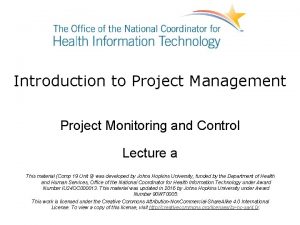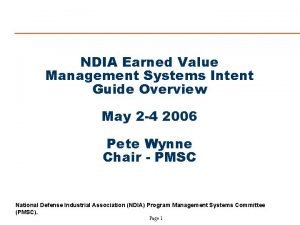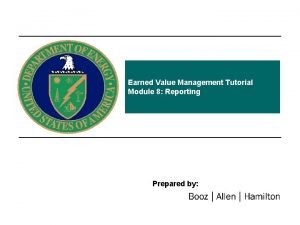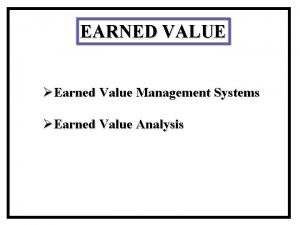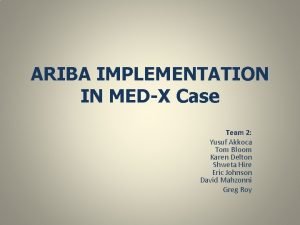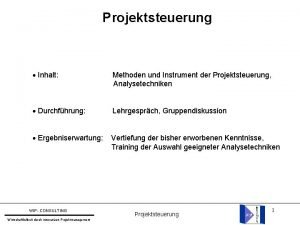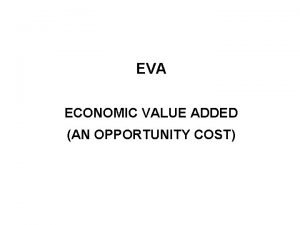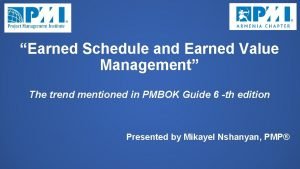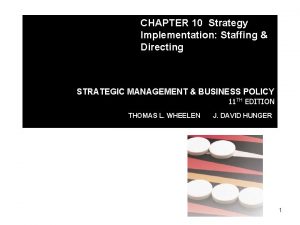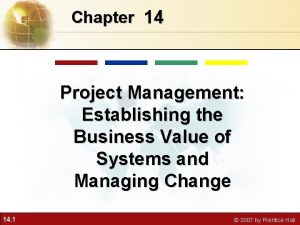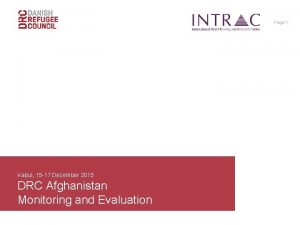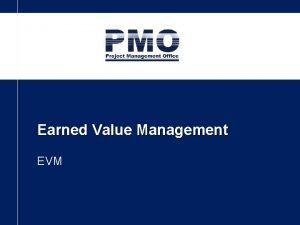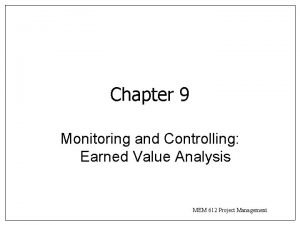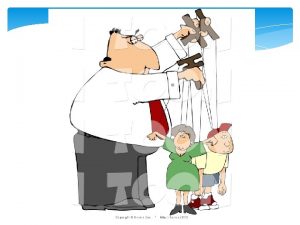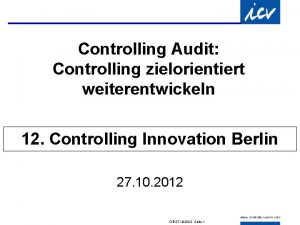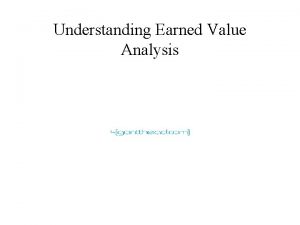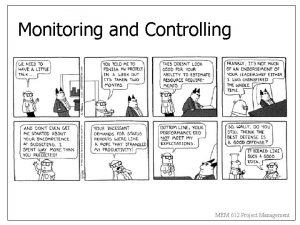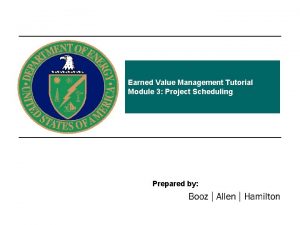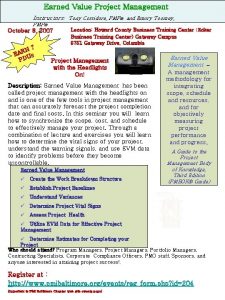Project Management Monitoring and Controlling Earned Value Analysis
























- Slides: 24

Project Management Monitoring and Controlling: Earned Value Analysis

Monitoring and Information Systems • Evaluation and control of projects are the opposite sides of project selection and planning • Logic of selection dictates the components to be evaluated • The details of the planning expose the elements to be controlled • Monitoring is the collecting, recording, and reporting information concerning any and all aspects of project performance MEM 612 Project Management

MEM 612 Project Management

The Earned Value Chart • One way of measuring overall performance is by using an aggregate performance measure called earned value • A serious difficulty with comparing actual expenditures against budgeted or baseline is that the comparison fails to take into account the amount of work accomplished relative to the cost incurred MEM 612 Project Management

The Earned Value Chart • The earned value of work performed (value completed) for those tasks in progress is found by multiplying the estimated percent completion for each task by the planned cost for that task • The result is the amount that should have been spent on the task so far • The concept of earned value combines cost reporting and aggregate performance reporting into one comprehensive chart MEM 612 Project Management

The Earned Value Chart Graph to evaluate cost and performance to date: MEM 612 Project Management

MEM 612 Project Management

The Earned Value Chart • Variances on the earned value chart follow two primary guidelines: – 1. A negative is means there is a deviation from plan—not good – 2. The cost variances are calculated as the earned value minus some other measure • • • EV - Earned Value: budgeted cost of work performed AC - actual cost of work performed PV - Planned Value: budgeted cost of work scheduled ST - scheduled time for work performed AT - actual time of work performed MEM 612 Project Management

The Earned Value Chart EV - AC = cost variance (CV, overrun is negative) EV - PV = schedule variance (SV, late is negative) ST - AT = time variance (TV, delay is negative) If the earned value chart shows a cost overrun or performance underrun, the project manager must figure out what to do to get the system back on target Options may include borrowing resources, or holding a meeting of project team members to suggest solutions, or notifying the client that the project may be late or over budget MEM 612 Project Management

The Earned Value Chart • Variances are also formulated as ratios rather than differences – Cost Performance Index (CPI) = EV/AC – Schedule Performance Index (SPI) = EV/PV – Time Performance Index (TPI) = ST/AT • Use of ratios is particularly helpful when comparing the performance of several projects MEM 612 Project Management

MEM 612 Project Management

Variance Analysis Questions • What is the problem causing the variance? • What is the impact on time, cost, and performance? • What is the impact on other efforts, if any? • What corrective action is planned or under way? • What are the expected results of the corrective action? MEM 612 Project Management

Example Planned $1500 to complete work package. Scheduled to have been finished today. Actual expenditure to date is $1350. Estimate work is 2/3 complete. What are cost and schedule variances? MEM 612 Project Management

Cost variance = EV – AC = $1500(2/3) - $1350 = $1000 - $1350 = -$350 MEM 612 Project Management

Schedule variance = EV – PV = $1500(2/3) - $1500 = -$500 MEM 612 Project Management

CPI (cost performance index) CPI = EV/AC =($1500/(2/3) / $1350) = 1000/1350 = 0. 74 MEM 612 Project Management

SPI (schedule performance index) SPI = EV/PV = ($1500(2/3))/$1500 = $1000/$1500 = 0. 67 MEM 612 Project Management

ETC and EAC Estimate to complete = (BAC-EV)/CPI =(1500 -1000)/. 74 = $676 Estimate at completion = ETC + AC = $676 + $1350 = $2026 MEM 612 Project Management

MEM 612 Project Management

MEM 612 Project Management

MEM 612 Project Management

MEM 612 Project Management

MEM 612 Project Management

MEM 612 Project Management
 Project monitoring and control
Project monitoring and control Earned value management in ms project
Earned value management in ms project Ndia evms intent guidelines
Ndia evms intent guidelines Earned value management tutorial
Earned value management tutorial Reviewer comments
Reviewer comments Earned value management tutorial
Earned value management tutorial Auw gold
Auw gold Evm gold card
Evm gold card Earned value management example
Earned value management example Earned value management tutorial
Earned value management tutorial Earned value management gold card
Earned value management gold card Ariba implementation at med-x
Ariba implementation at med-x Kostentrendanalyse
Kostentrendanalyse Eva finance
Eva finance Earn value management
Earn value management Contoh value creation adalah
Contoh value creation adalah Importance of software project management
Importance of software project management Spi acronym project management
Spi acronym project management M&e cycle
M&e cycle Spm unit 4 notes
Spm unit 4 notes Controlling management function
Controlling management function Staffing and directing
Staffing and directing Business value management
Business value management Differentiate monitoring from evaluation
Differentiate monitoring from evaluation Example of monitoring and evaluation in project proposal
Example of monitoring and evaluation in project proposal
